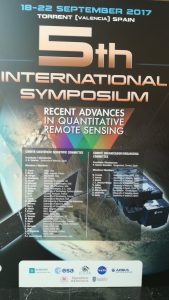MAJA presentation at the Recent Advances in Quantitative Remote Sensing symposium, fifth edition
I just came back from Valencia, where I attended the fifth edition of the Recent Advances in Quantitative Remote Sensing Symposium. It is one of my favourites, thanks to an amazing team of organizers led by Jose Sobrino. It is a unique symposium, because it has only one session where you can even see opticians listen to radarists, or passive microwaves experts share ideas with active microwave experts ! Every three years, it is a way to gather quickly a good sense of the advances in each domain of remote sensing, over lands mainly. Next RAQRS will happen in 2020 in Valencia, and no doubt I’ll be there, and not only for the delicious coffee breaks or for the giant paella. Of course, my talk, available here or visible below, was about Sentinel-2 L2A products, including cloud detection and atmospheric correction. This time, I focused on product validation and provided a lot of validation results obtained by our little team at CNES and CESBIO, with special thanks to Camille Desjardins (CNES) and Bastien Rouquié (CESBIO) and Magdalena Main-Knorn (DLR). I also provided a comparison of MAJA and Sen2cor for various criteria that all show the benefits of using multi-temporal information, as done in MAJA. Despite all that, and although these results were perfectly known by ESA, ESA decided to stick with Sen2cor in their production, supposed to be global next year. The slides explain how this decision was made. Anyway, as you probably know, you can access MAJA products from Theia, or you may also download MAJA’s executable (if you have a powerful linux computer).
https://www.cesbio.cnrs.fr/multitemp/wp-content/uploads/sites/11/2017/09/MAJA_advances.pdf








